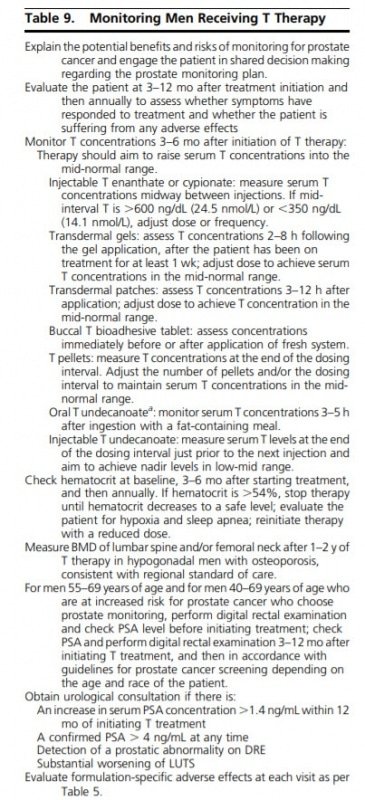
No earth-shattering changes except that now they mention estradiol in different tables but do not recommend estradiol testing.
“We recommend making a diagnosis of hypogonadism only in men with symptoms and signs consistent with testosterone (T) deficiency and unequivocally and consistently low serum T concentrations. We recommend measuring fasting morning total T concentrations using an accurate and reliable assay as the initial diagnostic test. We recommend confirming the diagnosis by repeating the measurement of morning fasting total T concentrations. In men whose total T is near the lower limit of normal or who have a condition that alters sex hormone–binding globulin, we recommend obtaining a free T concentration using either equilibrium dialysis or estimating it using an accurate formula. In men determined to have androgen deficiency, we recommend additional diagnostic evaluation to ascertain the cause of androgen deficiency. We recommend T therapy for men with symptomatic T deficiency to induce and maintain secondary sex characteristics and correct symptoms of hypogonadism after discussing the potential benefits and risks of therapy and of monitoring therapy and involving the patient in decision making. We recommend against starting T therapy in patients who are planning fertility in the near term or have any of the following conditions: breast or prostate cancer, a palpable prostate nodule or induration, prostate-specific antigen level > 4 ng/mL, prostate-specific antigen > 3 ng/mL in men at increased risk of prostate cancer (e.g., African Americans and men with a first-degree relative with diagnosed prostate cancer) without further urological evaluation, elevated hematocrit, untreated severe obstructive sleep apnea, severe lower urinary tract symptoms, uncontrolled heart failure, myocardial infarction or stroke within the last 6 months, or thrombophilia. We suggest that when clinicians institute T therapy, they aim at achieving T concentrations in the mid-normal range during treatment with any of the approved formulations, taking into consideration patient preference, pharmacokinetics, formulation-specific adverse effects, treatment burden, and cost. Clinicians should monitor men receiving T therapy using a standardized plan that includes: evaluating symptoms, adverse effects, and compliance; measuring serum T and hematocrit concentrations; and evaluating prostate cancer risk during the first year after initiating T therapy.”
Fullpaper can be downloaded by registered members. Register here







